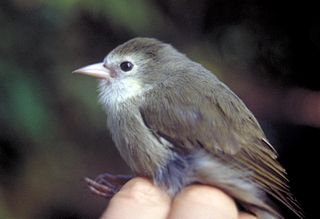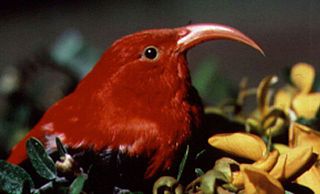Located about 2300 miles (3680 km) from the nearest continental shore, the Hawaiian Islands are the most isolated group of islands on the planet. The plant and animal life of the Hawaiian archipelago is the result of early, very infrequent colonizations of arriving species and the slow evolution of those species—in isolation from the rest of the world's flora and fauna—over a period of at least 5 million years. As a consequence, Hawai'i is home to a large number of endemic species. The radiation of species described by Charles Darwin in the Galapagos Islands which was critical to the formulation of his theory of evolution is far exceeded in the more isolated Hawaiian Islands.

The ʻōʻū is a species of Hawaiian honeycreeper endemic to the Hawaiian islands. It has a dark green back and olive green underparts; males have a yellow head while females have a green head. Its unusual beak seems to be adapted to feeding on the fruits of Freycinetia arborea. It has a strong flight which it uses to fly considerable distances in search of this vine, but it will eat other fruits, buds, flowers and insects.

The Oʻahu ʻakialoa is an extinct species of Hawaiian honeycreeper in the subfamily Carduelinae of the family Fringillidae. It was endemic to the island of Oʻahu in Hawaii.

The lesser ʻakialoa is an extinct species of Hawaiian honeycreeper in the subfamily Carduelinae of the family Fringillidae. It was endemic to the island of Hawaiʻi. It became extinct due to habitat loss and disappeared at around the same time as its Oʻahu relative.

The Kauai ʻakialoa was a Hawaiian honeycreeper in the subfamily Carduelinae of the family Fringillidae. It was endemic to the island of Kauai, Hawaii. It became extinct in the 20th century due to introduced avian disease and habitat loss. The Kauai ʻakialoa was about seven and a half inches in length and had a very long downcurved bill, which covered one third of its length. The adult males were bright olive-yellow on top and yellow on the bottom. The throat, breast, and sides of the body were olive-yellow. The females, however, were green-gray above and had a shorter bill.

The Oʻahu ʻamakihi is a species of Hawaiian honeycreeper in the family Fringillidae. The male is rich yellow below, sharply contrasted with greenish upper parts. Females are duller and have two prominent wing-bars. It has a total length of approximately 4.5 inches (11 cm). It is endemic to the island of Oʻahu in Hawaiʻi, and is likely the only surviving honeycreeper endemic to the island.

Hemignathus is a genus of Hawaiian honeycreepers in the subfamily Carduelinae of the family Fringillidae. All species are endemic to Hawaii.

The ʻakiapōlāʻau, pronounced ah-kee-ah-POH-LAH-OW, is a species of Hawaiian honeycreeper that is endemic to the island of Hawaii. Its natural habitats are dry and montane moist forests, and the only bird species on the island to occupy the woodpecker niche. The bird is 5.5 inches (14 cm) in length, and has an unusually curved beak-(a specialist species). The ʻakiapolaʻau is a pudgy bird which has a whitish bottom and tail, black legs, yellow chest, orangish head, black face mask and bill and gray black wings. The male's song is either a loud, short pit-er-ieu or a rapid warba-warba. Its various calls include an upslurred whistle, a short cheedle-ee warble, and a short sweet. Due to the recent disappearance of the Kauai nukupuʻu in the 1900s and the Maui nukupuʻu in the 1990s, leading to fears that they may be extinct, the ʻakiapōlāʻau may be the last of its genus. It is the only member of the subgenus Heterorhynchus, which has a woodpecker-like feeding habitat and exclusively preys on insects, in contrast to the nukupu'us, which were both insect-eaters and also hummingbird-like nectarivores.

The ʻakikiki, also called the Kauaʻi creeper, is a critically endangered Hawaiian honeycreeper endemic to Kauaʻi, Hawaiʻi. It is the only member of the genus Oreomystis. Of the Hawaiian birds known to be extant, it is thought to be the most endangered, with only 454 wild individuals known as of 2018. A survey report in 2021 estimated the population at 45 with a 5 percent annual decrease, and in July 2023 the remaining number of wild birds was estimated to be just 5 individuals. This species is predicted to be extinct in the wild in 2023.

The kākāwahie or Molokaʻi creeper is an extinct species of Hawaiian honeycreeper. It was found on the Hawaiian island of Molokaʻi in Hawaii.

Paroreomyza is a genus of Hawaiian honeycreeper in the subfamily Carduelinae of the family Fringillidae. These birds are endemic to Hawaii.

The Maui ʻalauahio, also known as the Maui Nui ʻalauahio or Maui creeper, is a species of Hawaiian honeycreeper. It is endemic to Maui Nui, Hawaii. The name Maui ʻalauahio is somewhat misleading because the species seems to have occurred on most, if not all, parts of the ancient Maui Nui, which includes the present day islands of Maui, Molokaʻi, Lānaʻi, and Kahoʻolawe. There are two subspecies: the Lānaʻi ʻalauahio, P. montana montana, which occurred on Lānaʻi (extinct); and P. montana newtoni which occurs on Maui. The common name refers to both groups.

The kiwikiu or Maui parrotbill is a species of Hawaiian honeycreeper endemic to the island of Maui in Hawaii. It can only be found in 50 square kilometres (19 sq mi) of mesic and wet forests at 1,200–2,150 metres (3,940–7,050 ft) on the windward slopes of Haleakalā. This species is critically endangered, with an estimated population in 2016 of 250-540 individuals, but more recent estimates of less than 150 individuals. Fossil evidence indicates that the bird could at one time be seen in dry forests at elevations as low as 200–300 metres (660–980 ft), as well as on the island of Molokaʻi.

The lesser koa finch is an extinct species of Hawaiian honeycreeper in the subfamily Carduelinae of the family Fringillidae. It was endemic to the island of Hawaiʻi.

The Maui nukupuʻu is a species of nukupuʻu Hawaiian honeycreeper that was endemic to the island of Maui in the Hawaiian Islands. The small, five-inch-long bird lived only in eastern Maui, where it was dependent on high-elevation mesic and wet forests of ʻōhiʻa lehua and koa. These two species of trees attract insects, causing the Maui nukupuʻu to have a higher chance of finding a meal near these trees. It was last sighted in the late 1990's, and is most likely extinct.

The Oʻahu ʻakepa is an extinct species of ʻakepa that was endemic to the island of Oahu. It was commonly sighted throughout the 19th century. This brick red Hawaiian honeycreeper was found in the mountain peaks in densely forested areas. The females were mostly gray with a tinge of green. The birds had a slight crossbill just like the other Loxops species. It used its crossbill to open up buds in search for nectar and insects for it to eat. Its most common haunts were the ʻōhiʻa and koa forests that were filled with the many flowers and insects that this species liked to eat. The Oʻahu ʻakepa is one of three different species of ʻakepa that were spread by possible weather and migration. The movement of the species stopped causing the species to break into four branches. The first branch was the Hawaiian ʻakepa, a scarlet- red bird that lives only on the Big Island and may be the ancestor of the genus Loxops. Next is the Maui ʻakepa, which was found as fossils on all the islands of Maui Nui, but was historically seen on Maui. It is a grayish-orange bird that was the first of the ʻakepa species to disappear. Then came the Oʻahu ʻakepa, which is a brick red color and was seen till around the 1900s when it became extinct. The last branch was the ‘akeke‘e, a green bird that is only found on the island of Kauai.

The Oʻahu nukupuʻu is an extinct species of nukupuʻu, a type of Hawaiian honeycreeper native to Oahu, which was similar to its cousins from the Islands of Kauaʻi and Maui. It is yellowish greyish with a long hooked beak to find insects. This bird is now extinct due to human activity.

Hawaiian honeycreepers are a group of small birds endemic to Hawaiʻi. They are members of the finch family Fringillidae, closely related to the rosefinches (Carpodacus), but many species have evolved features unlike those present in any other finch. Their great morphological diversity is the result of adaptive radiation in an insular environment. Many have been driven to extinction since the first humans arrived in Hawaii, with extinctions increasing over the last 2 centuries following European discovery of the islands, with habitat destruction and especially invasive species being the main causes.


















